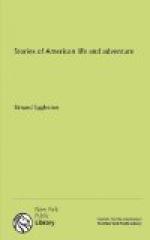The people at Plymouth did not know how to plant the corn they had found, but Squanto taught them. By watching the trees, the Indians knew when to put their corn into the ground. When the young leaf of the white oak tree was as large as a squirrel’s ear, they knew that it was time to put their corn into the ground. Squanto taught the white people how to catch a kind of fish which were used to make their corn grow. They put one or two fishes into each hill of corn, but they were obliged to watch the cornfield day and night for two weeks after planting. If they had not watched it, the wolves would have dug up the fishes, and the corn with them.
The white people learned also to cook their corn as the Indians did. They learned to eat hominy and samp, and these we still call by their Indian names. “Succotash” is another Indian word. The white people learned from the Indians to use the husks of Indian corn to make things. The Indians made ropes of corn husks, and in some places they made shoes of plaited husks. The white people in early times made their door mats and horse collars and beds of corn husks. They also twisted and wove husks to make seats for their chairs.
Of all the plants that grew in America, Indian corn was the most important to the Indians. It was also of the most value to the first white people who came to this country.
SOME WOMEN IN THE INDIAN WARS.
When white people first came to this country, they had much trouble with the Indians. After a while, when they had learned to defend themselves and got used to danger, they did not mind it much. Even the women became as brave as soldiers.
In very early times there were some families of people from Sweden living not far from where Philadelphia now stands. One day the women were all together boiling soap. It was the custom then to make soap at home. Water was first poured through ashes to make lye. People put this lye into a large kettle, and then threw into it waste pieces of meat and bits of fat of all kinds. After boiling a long time, this mixture made a kind of soft soap, which was the only soap the early settlers had. The large kettle in which the soap was boiled was hung on a pole. This pole was held up by two forked sticks driven into the ground. A fire was kept burning under the kettle. Of course, this soap boiling took place out of doors.
Some Indians, creeping through the woods, saw the women together without any men. They thought it a good chance to kill them or make them prisoners; but the women caught sight of the Indians, and ran away to their little church. The churches in that day were often built so they could be used for forts. The church to which these women ran was one of this kind. But the women had no guns with them. They knew that when they got into the church they would have nothing to fight with. So two of them took hold of the ends of the pole on which the kettle of boiling soap was hanging, and carried the kettle into the little church with them.




